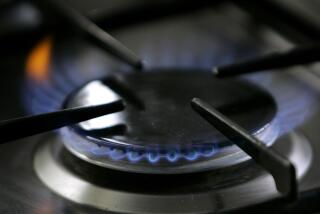Gas Logs Warm Hearths Without the Hassles of Wood
- Share via
With the holidays and cold weather upon us, the idea of sitting beside a cozy wood-burning fireplace is very appealing. As nice as it is, though, there are some problems with burning wood.
Beside the expense of purchasing firewood, there is the hassle of having to carry heavy logs and set them up inside a sooty fireplace. You need to have room to store the wood somewhere on your property and keep it dry, while avoiding storing it too close to the building as it attracts rats, spiders and termites.
Burning wood leaves messy ashes that have to be shoveled out of the fireplace, and the smoke leaves a flammable residue on the inside of the chimney flue, which needs to be cleaned out periodically to avoid a serious fire hazard.
But there is a way to have the warm glow of a wood fire without the negatives. Available from most major home centers and fireplace shops, “gas log sets” can be utilized in most any wood-burning fireplace that has a built-in gas log lighter. These sets come in a variety of sizes to fit fireplaces of all dimensions.
The beauty of the gas logs is that when they are properly set up you cannot tell from more than a few feet from the fireplace that they are not wood. The logs are textured, colored and shaped to look like wood and the flames from the burning gas encircle the wood, coming up from below to emulate a wood fire.
The capper though is the glowing embers. There is a tray full of sand positioned below the logs through which the gas is disbursed. On the surface of the sand is placed special tufts of fiberglass that glow orange below the length of the logs when the fire is lit. The resemblance to real glowing embers from a wood fire is truly amazing, giving the fire a remarkably authentic appearance.
Prices range from $100 for the smaller sets up to $300 or more for larger sizes. Installation is fairly easy for homeowners who have some basic skills with plumbing as the existing gas log lighter needs to be taken out and new gas fittings installed. Most professional plumbers can do this job in less than an hour.
Whether you install the set yourself or have someone do it for you, it is imperative that the flue damper block be properly installed to avoid possible carbon monoxide poisoning. As with a wood fire, the damper must be open to allow fumes to exit the room. But since there is no smoke from gas logs, there is no warning of a closed damper if you forget to open it, thus exposing the room occupants to dangerous gases. The damper block is a small clamp positioned on the edge of the flue damper designed to keep it from fully closing so that fumes can still exit even if the damper is shut.
For those who miss the smell and crackle of a wood-burning fire, check with your local fireplace shop for products that replicate those characteristics of wood fires for gas log sets. Call around as not all stores carry them.
*
Gary Abrams is a general contractor who has written about home improvement for The Times for 10 years. Comments and questions can be sent to him at [email protected].


